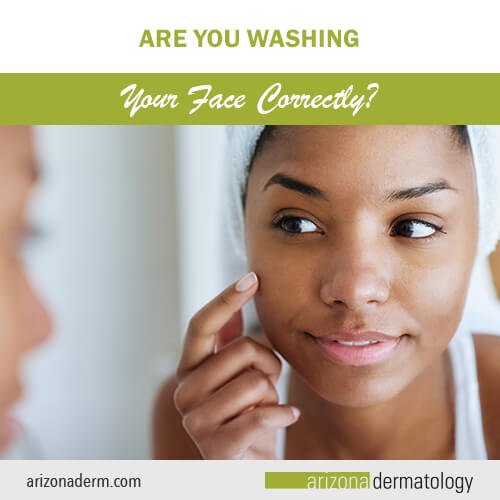 10 Things Most of Us Are Doing Wrong
10 Things Most of Us Are Doing Wrong
It seems like a simple thing, washing your face, but believe it or not, a lot of people get it wrong. Well intentioned mistakes when washing your face can lead to irritation, acne, and a less-than-optimal appearance. If you’re going to wash your face, why not get it right? Here are 10 mistakes a lot of people make when washing their face, and our dermatologists’ recommendations for fixing them.
- Washing too often. Optimally, you’ll only wash your face twice a day: once in the morning at once at night with a quick wash in between if you’ve perspired a lot. Washing your face multiple times a day to remove germs isn’t recommended (and if you have acne, it won’t help it). On the contrary, overwashing leads to dry, irritated skin and prompts the skin to overproduce oil—the opposite of what you want acne-prone skin to do.
- Forgetting to wash at night. The most important time to wash your face is before you go to bed at night. Even if you don’t wear makeup, natural oils, sweat and environmental pollutants build up on the outer layer of your skin over the course of a day. Washing these off your face every night reduces the chances of skin irritation, inflammation, and acne breakouts. It can also help keep skin looking younger. (The second most important time to wash your face is in the morning when you wake up to cleanse your face of any bacteria from saliva or oils from your hair that were transferred from your pillowcase to your face while you slept.)
- Using the wrong cleanser. The “right” cleanser to use will depend on your skin type and whether you have any skin conditions, like acne or rosacea. Use a gentle, non-abrasive cleanser and avoid products containing alcohol and a lot of dyes or fragrances. Gel or foaming cleansers work for oily skin, but dry or sensitive skin should opt for a thicker, creamier cleanser. Water-based cleansers work well for normal skin. If you’re not sure what type of cleanser to use, check with your dermatologist.
- Cleansing with hot water. Hot water strips your skin of the natural oil barrier that helps skin maintain its integrity, making it more prone to drying out and flaking. Excessive heat can also exacerbate rosacea. Instead, people of all skin types should wet, wash and rinse their skin with lukewarm water… not hot. (That goes for showers, too!)
- Scrubbing too hard. Any time you use anything other than your fingers to apply cleanser, you can harm your skin. Washcloths, sponges, and exfoliating brushes aren’t necessary and can irritate skin and damage areas like the skin around the eyes. Instead, apply cleanser and lather it on your face gently in a circular motion for 20 to 30 seconds. Pay special attention to the T-zone and the jawline. Once you’ve gotten a nice lather going, rinse and pat try. No scrubbing necessary!
- Overusing exfoliants. We just told you not to wash your face regularly with an exfoliant, but the truth is it’s okay to use an exfoliant once in a while. Scrubs or chemical exfoliants like salicyclic or glycolic acid can be effective at unclogging pores and removing dead skin cells and dirt, which can brighten skin and improve its look, but don’t overdo it. If you do choose to exfoliate, aim for just a few times a week. If you have dry or sensitive skin, limit exfoliation to only a couple of times a month unless your dermatologist says differently.
- Re-using the same towel. After you’ve rinsed your face, pat (don’t rub) your skin dry with a clean towel. It can seem excessive to change your face towel after one or two uses, but re-using the same towel too many times can spread bacteria back onto your face after you’ve washed it, contributing to acne. We recommend investing in an inexpensive set of small washcloths that can be dedicated specifically to your face-washing routine.
- Applying moisturizer too late. Most moisturizers contain two types of ingredients: humectants (which draw moisture into the skin) and occlusive ingredients (which seal that moisture in). If you wait until your skin is perfectly dry before applying moisturizer, you’re missing out on the product’s occlusive properties. Instead, apply the moisturizer while your skin is still damp to help trap even more moisture in.
- Not cleansing after using makeup wipes. Make-up wipes can help remove heavy or dark makeup, but they don’t replace a proper cleanse. Commercial wipes contain chemicals and preservatives that leave a residue behind and can irritate sensitive skin. If you choose to use makeup wipes, follow them up with a gentle cleansing routine using the tips outlined above.
- Skipping the dermatologist. With so many products available in stores and online, it’s difficult to know the right combination of skincare products to use. Rather than investing in the wrong thing or wasting your money on something that won’t work for your skin or deliver on its claims, why not make an appointment with your dermatologist? A board-certified dermatologist can help you whether you have a medical skin condition or simply want to keep your skin healthy and looking its best.


